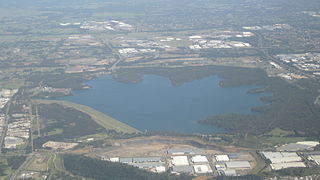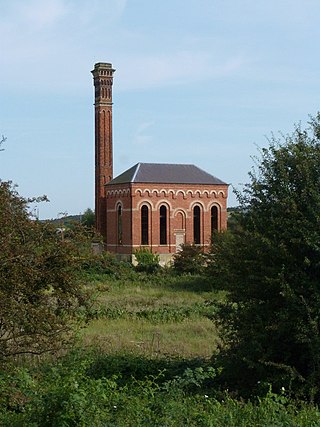
Blagdon Lake lies in a valley at the northern edge of the Mendip Hills, close to the village of Blagdon and approximately 10 miles (16 km) south of Bristol, England. The lake was created by Bristol Water, when it dammed the River Yeo, starting construction in 1898, to designs by Charles Hawksley, and completing this in 1905. The Wrington Vale Light Railway was constructed primarily to bring building materials for the lake.

Papplewick Pumping Station, situated in open agricultural land approximately 3 miles (4.8 km) by road from the Nottinghamshire village of Papplewick, was built by Nottingham Corporation Water Department between 1881 and 1884 to pump water from the Bunter sandstone to provide drinking water to the City of Nottingham, in England. Two beam engines, supplied with steam by six Lancashire boilers, were housed in Gothic Revival buildings. Apart from changes to the boiler grates, the equipment remained in its original form until the station was decommissioned in 1969, when it was replaced by four submersible electric pumps.

The Prospect Reservoir is a heritage-listed 50,200-megalitre potable water supply and storage reservoir created by the Prospect Dam, across the Prospect Creek located in the Western Sydney suburb of Prospect, in New South Wales, Australia. The eastern bounds of the reservoir are a recreational area and the western periphery are within the bounds of Western Sydney Parklands. It was added to the New South Wales State Heritage Register on 18 November 1999.

Mount Crosby pumping station is a heritage-listed pumping station and weir at Stumers Road, Mount Crosby, City of Brisbane, Queensland, Australia. It is located on the Brisbane River and extends into Chuwar on the other side of the river. The facility supplies water to Brisbane and nearby cities and towns within the SEQ Water Grid. It was originally designed by Charles H McLay and built from 1891 to 1892. The historic parts of the facility were added to the Queensland Heritage Register on 25 October 2019. It is also listed on the Brisbane Heritage Register, together with numerous associated facilities which were not included in the state heritage listing.

The Knight Reservoir is a large pumped storage reservoir located in the Borough of Elmbridge in Surrey. It was inaugurated in 1907 and stores up to 2,180 million litres of raw water abstracted from the River Thames prior to its treatment and supply to London and north Surrey. It is located south of the River Thames, west of West Molesey, and between Hurst Road (A3050) and Walton Road (B369). It is adjacent to, and west of, its twin Bessborough Reservoir.

London's water supply infrastructure has developed over the centuries in line with the expansion of London. For much of London's history, private companies supplied fresh water to various parts of London from wells, the River Thames and the River Lea. Further demand prompted new conduits and sources, particularly when the Agricultural and Industrial Revolution caused a boom in London's population and housing.
William Clark was an English civil engineer and inventor.

Brede Waterworks is a waterworks at Brede, East Sussex, England. It was built to supply Hastings with drinking water. The waterworks still houses two of the three steam engines that were used to pump water from Brede to reservoirs at Fairlight and Baldslow.

The City of Nottingham Water Department (1912–1974), formerly the Nottingham Corporation Water Department (1880–1912), was responsible for the supply of water to Nottingham from 1880 to 1974. The first water supply company in the town was the Nottingham Waterworks Company, established in 1696, which took water from the River Leen, and later from springs at Scotholme, when the river became polluted. Other companies were set up in the late 18th century and in 1824, while in 1826 the Trent Water Company was established. They employed Thomas Hawksley as their engineer, who became one of the great water engineers of the period, and Nottingham had the first constant pressurised water supply system in the country. The various companies amalgamated in 1845, and Hawksley remained as the consulting engineer until 1879.

The British Engineerium is an engineering and steam power museum in Hove, East Sussex. It is housed in the Goldstone Pumping Station, a set of High Victorian Gothic buildings started in 1866. The Goldstone Pumping Station supplied water to the local area for more than a century before it was converted to its present use. The site has been closed to the public since 2006, and in March 2018 the entire complex was put up for sale.

The City of Beloit Waterworks and Pump Station was built in 1885 in Beloit, Wisconsin just below a hill on top of which sits the Beloit Water Tower. It was added to the National Register of Historic Places in 1990.

Copenhagen Waterworks opened in 1859 in Copenhagen, Denmark. Located in Studiestræde, between Axeltorv and H. C. Andersens Boulevard, it was Denmark's first waterworks and continued operations until 1951. The complex was designated an Industrial Heritage Site in 2007 and listed in 2010. The former engine house is now home to concert venue Pumpehuset. The other buildings house a daycare.

Burdekin River Pumping Station is a heritage-listed pumping station at Weir Road, Breddan, Charters Towers Region, Queensland, Australia. It was built from c. 1887 to 1910s. It is also known as Charters Towers Water Supply Scheme. It was added to the Queensland Heritage Register on 3 July 1995.

Potts Hill Reservoirs 1 and 2 are heritage-listed reservoirs at Cooper Road, Potts Hill, City of Canterbury-Bankstown, New South Wales, Australia. It was designed by Board of Water Supply and Sewerage and built from 1880. The reservoirs are now maintained by the Board's successor, Sydney Water. It was added to the New South Wales State Heritage Register on 18 November 1999.

Carrington Pump House is a heritage-listed former hydraulic power station at 106 Bourke Street, Carrington, City of Newcastle, New South Wales, Australia. It was built from 1877 to 1878 by William H. Jennings. It is also known as Hydraulic Engine House and Crane Bases Nos. 7, 8, 9 and 10 and Carrington Hydraulic Power Station. It was added to the New South Wales State Heritage Register on 25 August 2017.

The Ryde Pumping Station is a heritage-listed pumping station and offices located at Victoria Road, West Ryde, New South Wales, Australia. It was built from 1891 to 1921 by William Adams & Co. Ltd., State Monier Works, Refshaw & O'Brien. It is also known as Ryde Pumping Station and site, WP005 and West Ryde Pumping Station. The property is owned by Sydney Water. It was added to the New South Wales State Heritage Register on 15 November 2002.
Newcastle Reservoirs are heritage-listed former and disused reservoirs, now used for public tours, at 51 Brown Street, The Hill, City of Newcastle, New South Wales, Australia. They were designed by Cecil West Darley and the NSW Public Works Department and built from 1880 to 1918 by the Public Works Department. It is also known as Newcastle Reservoirs Site, Brown Street Reservoirs, Newcastle Reservoir No.1, Newcastle Pumping Station and Reservoir No.2 Valve House. The property is owned by the Hunter Water Corporation, an agency of the Government of New South Wales. The reservoirs were added to the New South Wales State Heritage Register on 27 April 2018.

Worksop Waterworks Company, its predecessors and successors have provided a public water supply, together with sewerage and sewage treatment facilities to the town of Worksop since the mid-19th century. Unlike many towns, the sewerage network was constructed before the water supply network, and there was official opposition to the idea of providing a water supply network.

Twyford Waterworks is a preserved pumping station and waterworks situated close to the village of Twyford and the city of Winchester in Hampshire, England. It is a scheduled monument and now operates as a museum. The site is leased by the Twyford Waterworks Trust and is open on selected days during the year.
Surrey Street pumping station is a grade 2 listed building that was built in four phases. It’s the site of a well that “had been more or less public ever since the town existed”. It was opened by the Archbishop of Canterbury on 11 December 1851, making Croydon one of the first towns to have a combined water and sewage system under the 1848 Public Health Act, and to Chadwick’s arterial-venous design. The water was pumped from the wells, up Park Hill to a cylindrical brick reservoir with a domed roof to provide a constant supply of fresh piped water. Prior to its opening, the inhabitants of Croydon used the river Wandle, streams and shallow wells, which were often contaminated by seepage from privies and cesspools. Parts of Norwood were served with water from the Lambeth Water Company, a private company established by an act of parliament in 1785.






















